Algae eaters (also sometimes referred to as “clean up crew”). are an integral part of the aquarium hobby, due to their ability to manage and help keep your algae levels in your tank under control.
Different species of fish or even an invertebrate such as a snail or shrimp, feed on specific types of algae while others graze more openly on multiple different types.
In this article, you’ll learn the guidelines I use when picking as well as my best go-to algae eaters, including fish, shrimp and snails. And also help you understand which type of algae they may target.
1. Otocinclus Catfish (Otocinclus sp.)
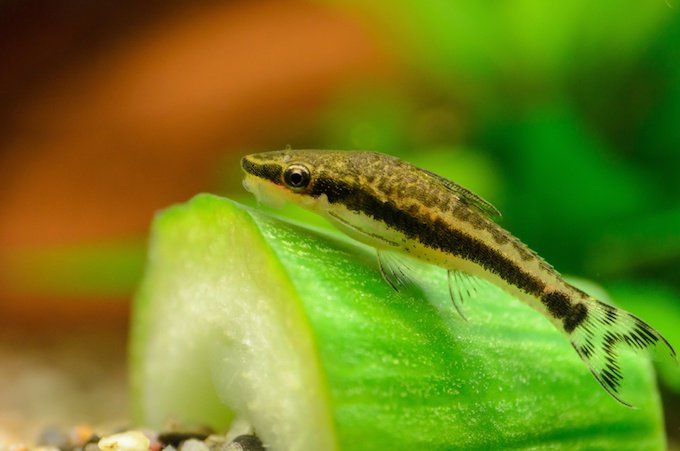
Minimum tank size: 30 gallons
One of the smallest algae eaters on this list, the otocinclus catfish grows to a maximum of 2 inches. This species is best kept in a group of five or more.
These fish are similar in appearance to the larger Chinese algae eater, but cuter and more peaceful.
This species does well in community tanks and gets along with other bottom-feeders, but they shouldn’t be kept with large or aggressive species like cichlids.
Otocinclus catfish are moderately easy to care for, but they do need a large tank of at least 30 gallons to ensure they have enough algae to feed on and because they are best kept in schools.
These fish are so good at what they do, that they sometimes starve to death because they’ve wiped out all the algae in the tank. Keep an eye out. If you’re not seeing any algae in the tank, you probably need to drop in some sinking pellets or blanched veggies for them to munch on.
You can check out our detailed guide on Otocinclus care here.
2. Bristlenose Plecostomus (Ancistrus temminckii)

Minimum tank size: 30 gallons
Also known as the bristlenose catfish, this species is named for the tentacle-like projections on its snout. Females only have a few tentacles around their mouths, but males have a large mass of them that grow from their snouts.
They’re so ugly, they’re cute.
This species does an excellent job of eating algae and also leftover fish food.
These fish are easy to care for, but be aware that they do grow to a length of 5 inches. Bristlenose plecos are compatible with most peaceful species and they will tolerate a range of tank conditions.
They can get quite territorial with their own kind; they’re best kept as just a single fish. They mostly ignore fish of other species
The minimum recommended tank size is 30 gallons and though they will feed on softer kinds of algae, they will generally require supplemental feeding with algae wafers.
3. Clown Pleco (Panaqolus maccus)
Minimum tank size: 20 gallons
Clown plecos are great little algae eaters for smaller tanks. This species only grows to about 3 inches long and they’ll eat soft algae off of rocks, plants and the glass.
They’re not great for tougher algae, like black beard or green spot.
The name “clown” comes from their pattern of irregular brown and mustard yellow stripes. They’re pretty cute.
They can be territorial with other plecos, so it’s best to just keep them as a single unless you have a large tank.
I’ve kept this species for years and have always enjoyed them. They can be a bit shy while the lights are turned on.
4. Twig Catfish (Rineloricaria lanceolate)
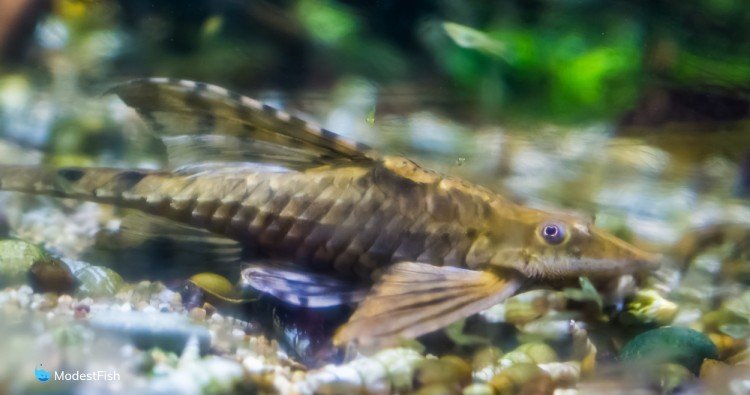
Minimum tank size: 15 gallons
These catfish have long, thin bodies and they grow to about 4 inches in length; they’re interesting little oddballs.
Twig catfish are docile, so they’re compatible with peaceful species such as tetras and livebearers, though they can be bullied by cichlids and larger fish.
Though they were once fairly uncommon, these fish are becoming increasingly more available as more aquarium hobbyists are learning about their benefits.
These fish are best kept in groups of three or more and require a tank size of at least 15 gallons.
They prefer moderately soft water with a pH between 6.0 and 8.0 – they do not take well to changes in water chemistry and they will feed on most types of algae but still require supplemental feeding.
Out of the algae eating fish on this list, the twig catfish is one that requires more specialized care than the others. They also need lots of places to hide in the tank because they tend to be very shy.
5. Mollies (Poecilia sphenops)
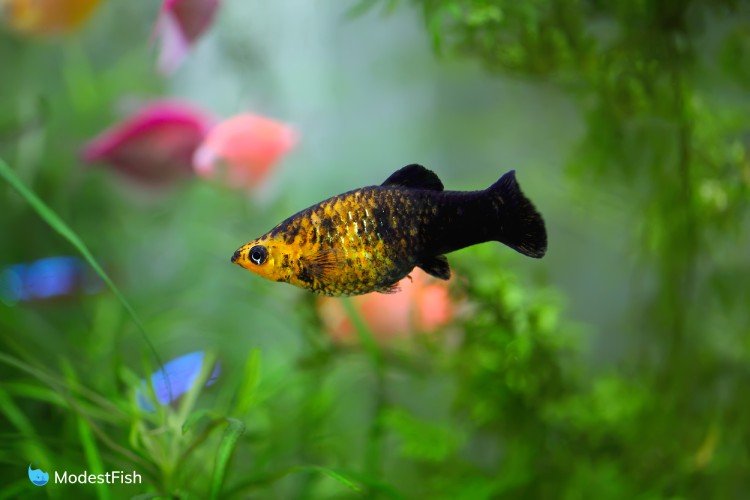
Minimum tank size: 40 gallons
Though they may not feed on algae as some of the other fish on this list, mollies and other livebearers will pick at filamentous algae if it is available.
On average, mollies grow 4 to 6 inches in length and they prefer a pH between 7.5 and 8.5.
Mollies need hard water to really thrive, with a GH (general hardness) of 60-180 ppm.
These fish are livebearers, and will produce lots of fry. But generally, if left to their own devices, the adults will eat the fry and keep the population from growing.
If you want fry to survive, provide them with lots of cover so they can hide from ravenous adults.
6. Florida Flag Fish (Jordanella floridae)
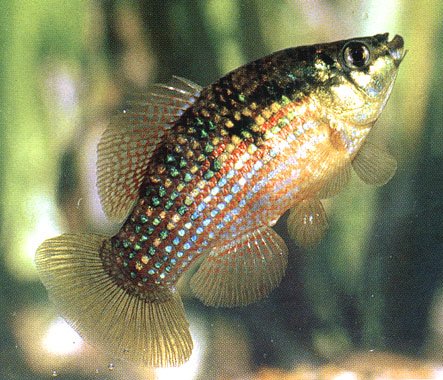
Minimum tank size: 40 gallons
A type of killifish, the Florida flag fish is named after its resemblance to the stars and stripes on the US flag. It’s a stunning little nano fish covered in bright green, red, blue and gold iridescent spots.
A mostly peaceful fish (can be aggressive during spawning), the Florida flag fish is one of the few on this list who will eat hair/thread algae. It is also known to eat black beard algae, and other fuzzy types.
Florida flag fish flourish in large tanks with lots of dense plant cover. They are best kept in a group of five or more.
They are known to jump, so you should have some kind of aquarium lid.
While flag fish can help keep down hair and thread, type algaes, they cannot scrape algae off of glass.
7. Hillstream Loach (Sewellia lineolata)
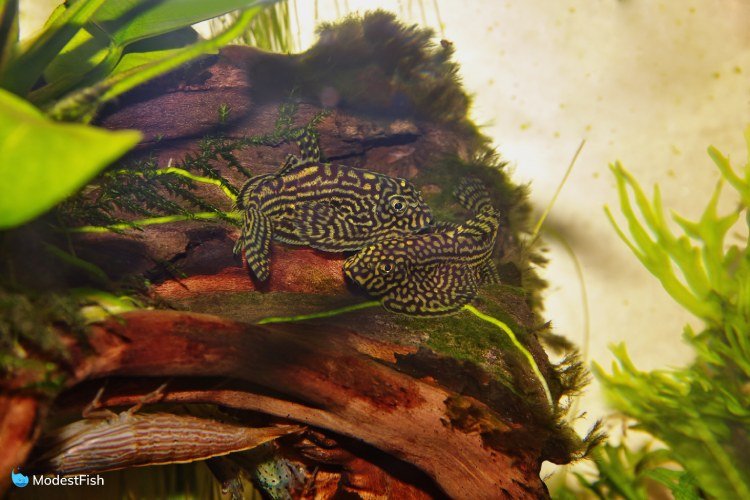
Minimum tank size: 20 gallons
The hillstream loach is, in my opinion, the coolest looking fish of the bunch. They look like a miniature stingray, and will scoot around the tank with a back-and-forth “walking“ motion that is really quite adorable.
Hillstream loaches use their modified ventral fins and suckermouth to cling to rocks, driftwood, plants, or aquarium glass.
Hillstreams do an excellent job of eating up all the algae on your glass and look fantastic while they do it.
This species of loach is hardy, and can adapt to a wide range of water parameters (65-75°F). They like lots of water flow and well oxygenated water.
Hillstreams tend to squabble amongst their own kind, but generally ignore other species of fish. You can keep them in a group of 3-4 (at least) to help even out any aggression.
8. Siamese Algae Eater (Crossocheilus oblongus)
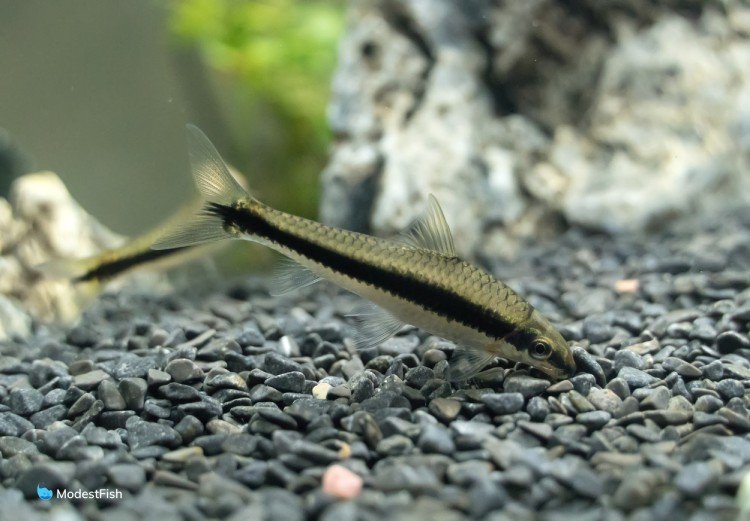
Minimum tank size: 55 gallons
The Siamese algae eaters feed on a variety of different types of algae.
These algae eaters are also great because they will eat some of the algae that other algae eaters ignore like black beard algae.
This species is also fairly peaceful and relatively easy to care for but, they need a tank size no smaller than 55 gallons.
The problem with this species is that, while they’re great algae eaters as juveniles, they often get lazy once they’re mature and prefer to live off of fish food that is dropped into the tank. It’s easier and tastier.
9. Chinese Algae Eater (Gyrinocheilos aymonieri)
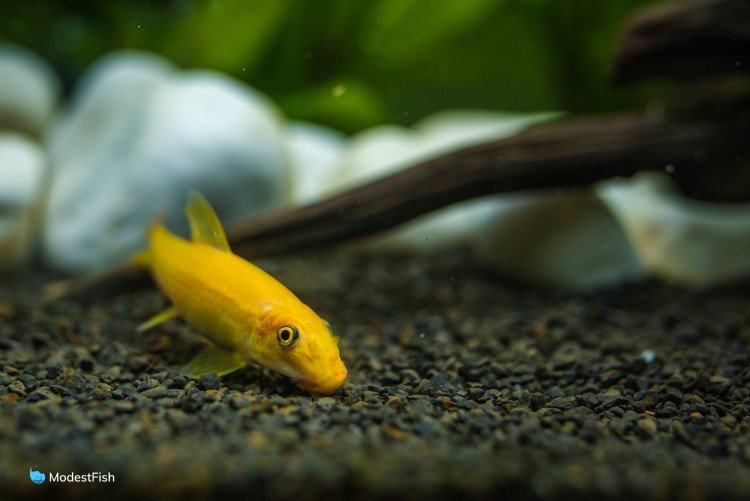
Minimum tank size: 55 gallons
The Chinese algae eater is easy to care for and does well in tanks at least 55 gallons in capacity.
These fish do grow fairly large, however – up to 10 inches – and they tend to become more aggressive as they grow.
For this reason, you should be careful about keeping them in a tank with delicate species of fish.
On the other hand, their aggression can be a good thing – they are one of the only algae eaters that can be kept with large and semi-aggressive species like cichlids.
Chinese algae eaters prefer warmer water temperatures and they will require supplemental food, like algae wafers or sinking shrimp pellets.
They are not one of the most effective algae eaters on the list because they tend to grow lazy as they get bigger, but they may feed on different kinds of algae while young.
10. Common Plecostomus
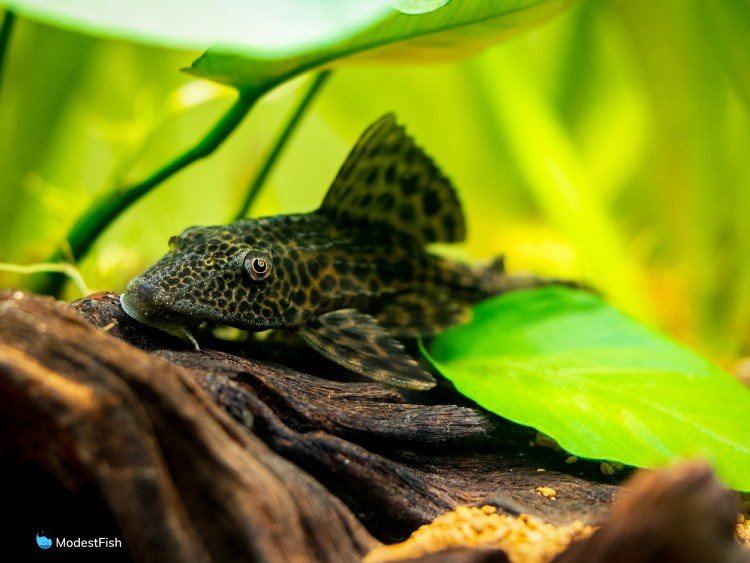
Minimum tank size: 125 gallons
The common pleco is widely available in most fish stores, is a great algae eater, but also requires an enormous tank!!
I love common plecos, I think their armor plating is really neat, and they look so prehistoric, but they are generally not a good fit for the average aquarist.
These fish can reach lengths of 18-24 inches.
They’re native to the Amazon, but can adapt to a wide variety of tank conditions.
They’ll eat most kinds of algae in its early stages, but won’t touch well-established patches of black beard algae.
Common plecos will usually require supplemental food. They especially like algae wafers and blanched zucchini.
11. Nerite Snail (Neritina sp.)
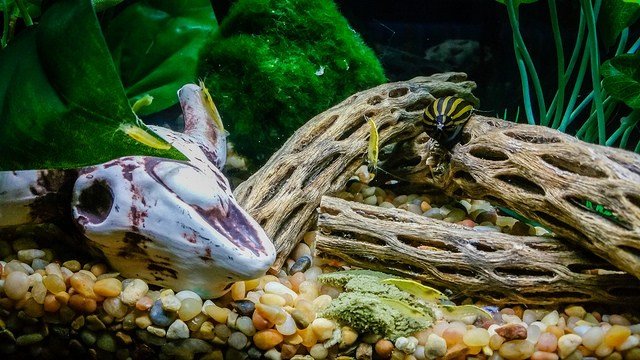
Several different species of snail are sold under the heading of “nerite snail,” and they come in a variety of colors and patterns: solid orange, striped, chevron and even ones that grow little horn-like protrusions from their shells.
These snails eat every type of algae, even the tougher types like green spot algae, and they work very quickly.
One thing to be mindful of is that these snails have a hard time turning over if they should fall on their back, so be careful when handling them.
Nerite snails grow to just over an inch in length so they are fairly small – this means you need to be careful about keeping them with large and predatory fish.
They can tolerate a wide range of water temperatures from 65°F to 85°F, so they can adapt to the conditions already in your tank.
Like most invertebrates, they require some hardness in the water for their shells.
The one drawback to these snails, while they do not reproduce successfully in a freshwater tank, the females do lay unsightly eggs all over the place that are very difficult to remove, and by difficult, I mean almost impossible.
12. Ramshorn Snail (Planorbidae)
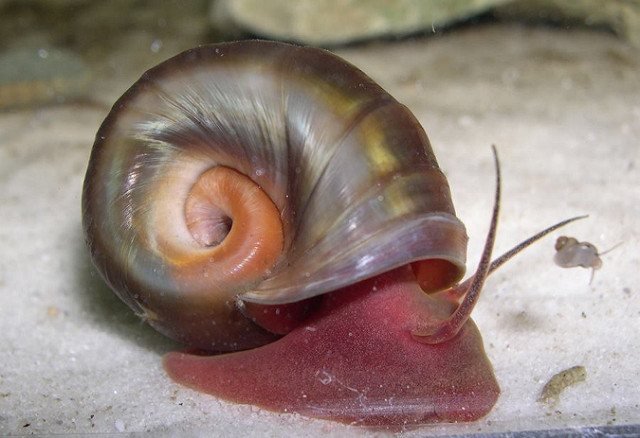
Named for the shape of their shell (spoiler alert: it’s shaped like a ram’s horn), these snails feed on a variety of different types of algae as well as uneaten fish food and decaying plant matter.
They do not, however, eat live plants and they do well with small and peaceful species of fish – they can become a target for cichlids, loaches, and other predatory fish.
Ramshorn snails grow up to an inch in size and they prefer neutral tank water around 7.0 pH. They can be kept singly, with other ramshorn snails, or with nerite snails.
Ramshorn snails come in a variety of colors: pink, orange, blue, black, brown and white.
The downside to these guys is that they do breed in the aquarium. Their population will grow to the size of their food source. So, if there is tons of algae and uneaten food in the tank, you may end up overrun with snails.
But hey, the algae will be gone!
13. Mystery Apple Snail (Pomacea bridgesii)
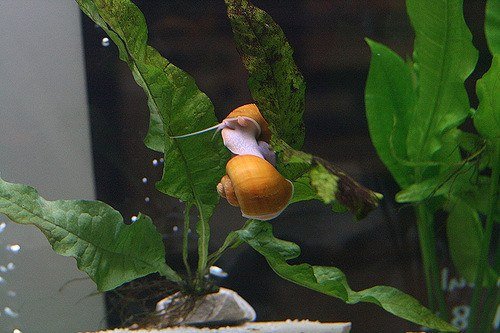
These snails come in various colors, though bright yellow is the most common, and they feed on most types of algae, but aren’t much help with black beard.
Mystery snails are able to fend for themselves, though they may be a target for predatory fish when they are very small.
They’re not the most voracious algae-eating snail, but they do eat some, and they are really great at finding uneaten food that has gotten past your fish.
These snails cannot right themselves if they end up upside down, and can actually drown if they get stuck this way. Be careful when handling them and make sure they’re right side up.
14. Malaysian Trumpet Snail (Melanoides tuberculata)
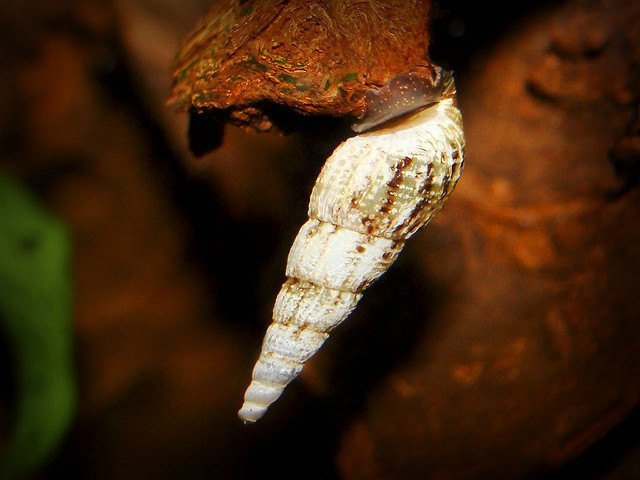
One of the smallest algae eaters on this list, the Malaysian trumpet snail grows under 1 inch in length and prefers to get soft algae.
These snails have long shells that come to a point and they can be found in a variety of different colors. Malaysian trumpet snails feed on several different types of algae, but they don’t feed on plants, so they’re a safe addition to your planted tank.
These guys need at least a 10 gallon tank and prefer a pH between 7.0 and 7.5. They are very easy to care for and do well in community tanks with peaceful species, though be careful because they reproduce quickly.
This species of snail also tends to plow through the substrate in search of food, so softer substrates are preferable.
15. Rabbit Snail (Tylomelania app.)
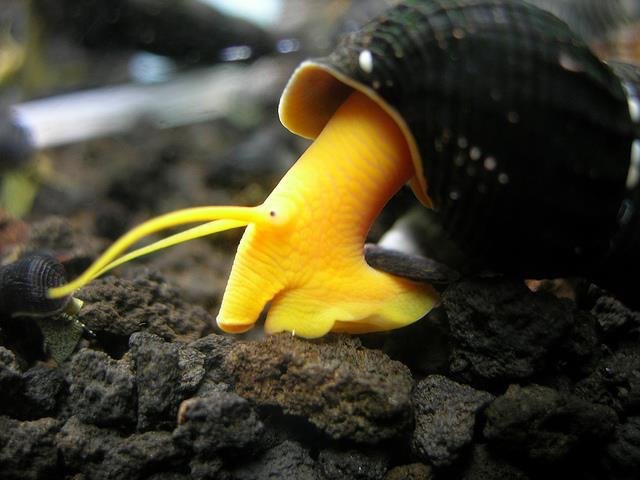
The rabbit snail is one of the larger species of algae-eating snails, growing up to 5 inches in length.
These snails have long, pointed shells similar to the Malaysian trumpet snail and they come in various shades of yellow and brown.
This species generally doesn’t feed on live aquarium plants with the exception of java fern, so be mindful of that.
Rabbit snails need at least 30 gallons of tank size and they prefer slightly cooler water temperatures between 68°F and 74°F.
These snails are fairly easy to care for, but since they burrow through the substrate, they do best with sand and aquasoils.
Rabbit snails consume decaying plant matter and other detritus in addition to algae and they do reproduce in the home aquarium, but very slowly.
16. Amano Shrimp (Caridina multidentata)
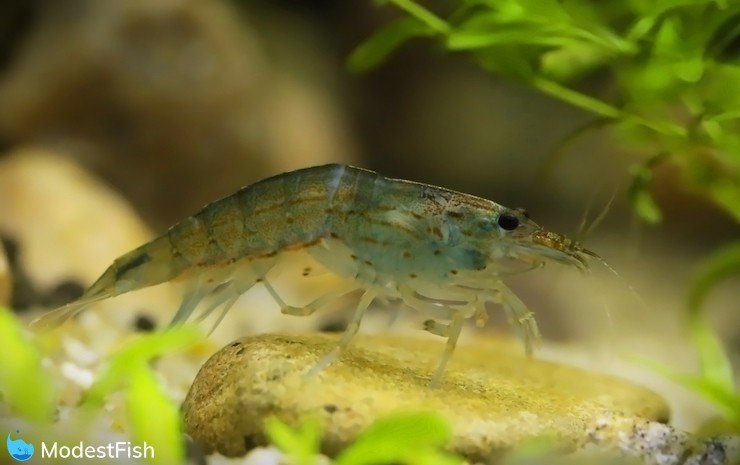
These shrimp are easy to care for and because they only grow up to 2 inches in length, they can be kept in fairly small aquariums.
Amano shrimp require soft to slightly hard water in the 6.5 to 7.5 pH range. They also prefer warmer water temperatures between 72°F and 78°F, though they are adaptable as long as their other needs are met.
This species does well in groups of three or more and they can be kept in tanks with small to medium-sized peaceful fish, though they may be a target for large and aggressive fish like cichlids and goldfish.
In addition to feeding on algae, these shrimps will also feed on uneaten fish food and other detritus.
17. Cherry Shrimp (Neocardidina davidii)
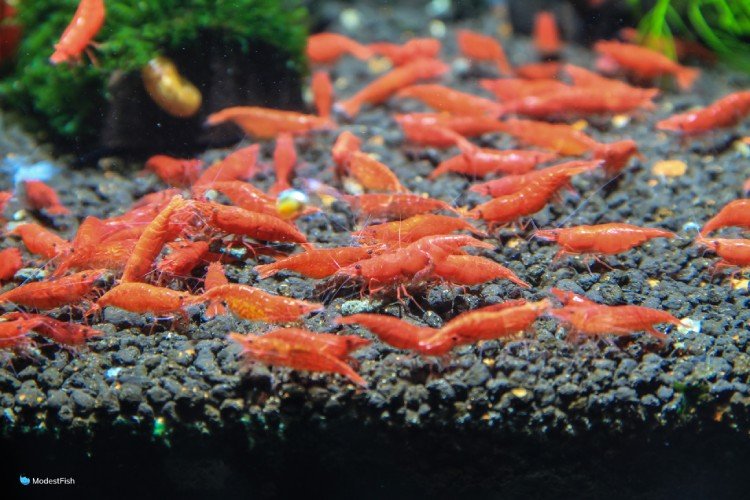
Named for their bright red color, cherry shrimp are a great addition to your freshwater cleanup crew.
These shrimp do best in groups of 2 to 4 and can be kept in tanks as small as 5 gallons. They prefer a pH range of 7.0 to 8.0 and a KH of 3 to 10 with a wide temperature range between 60°F and 80°F.
Cherry shrimp are easy to care for as long as they have algae to feed on, though they may consume other detritus as well. I supplement mine with sinking pellets two or three times a week.
They’re great at wiping out softer kinds of algae, but they are too small to eat black beard. This is why I mix them with Amano shrimp.
This species tends to thrive in planted tanks and they can get along with other peaceful tank inhabitants, though they may become prey for larger and carnivorous fish. It is best to keep them with nano fish.
Also, even peaceful fish will eat baby shrimp. If you want your cherry shrimp to breed, keep them in a shrimp only tank.
18. Ghost Shrimp (Palaemonetes sp.)

Aptly named for their see-through bodies, ghost shrimp are not quite as effective as Amano shrimp or cherry shrimp in the algae-eating department, but they will certainly help.
Ghost shrimp grow up to 2 inches in length and they are easy to care for in a 10 gallon tank with a temperature range of 68°F to 85°F, a KH between 3 and 10, and a pH between 7.0 and 8.0.
These shrimp are peaceful by nature and they make excellent scavengers for a community tank when kept with other small and non-aggressive species.
Choosing Your Best Algae Eater
Tank Size
The most important thing to think about when you’re picking an algae eater is the size of your tank.
Some algae eating fish get very, very large and are not appropriate for smaller tanks.
Also, some algae eaters need to live in groups. So you’ll need room to house, not just one fish, but five or six of them.
It is extremely important to do research about a species before you bring it home.
Fish are often sold as juveniles, so the cute little 3 inch (7.5 centimeters) suckermouth catfish you buy today could be over 18 inches (46 centimeters) long within a year.
Make sure you can take care of fish long term before you place them in your aquarium.
Type of Algae
Not all species of algae eaters will eat all species of algae.
If you are dealing with a specific type of algae, your best bet is to choose something that is known to eat it.
For instance, black beard algae is quite tenacious, and not many species of algae eater can make a meal of it.
For tanks with more large-scale algae problems, it may help to add two or three different types of algae eater to your tank (as long as they’re able to live with each other).
But what are the different types of algae you might find in your tank?
Here’s a quick overview:
- Hair algae – Also known as filamentous or thread algae, hair algae is light green and grows in wispy filaments. It grows quickly and attaches to any tank surface.
- Brown algae – Also known as diatoms, brown algae are single-celled algae. It starts out as a dusting over tank surfaces then turns into a thick mat over the course of several days.
- Blue green algae – Also known as cyanobacteria, blue green algae grows as a slimy coating that looks like a bright green membrane growing over the substrate. It is single-celled and starts with a spot or two but quickly spreads.
- Black beard algae – Often dark purple or black in color, black beard algae usually grows on aquarium plants. It puts out hair-like strands that can grow bushy, like a pirate’s beard…but way less cool.
- Green spot algae – This type of algae grows in tanks with bright lighting and it can be hard to remove. It typically grows on tank walls and slow-growing plants.
- Green dust algae – True to its name, green dust algae is a thin dusting of algae that covers all surfaces of the tank and it usually happens when the lighting is too bright. Luckily, this algae is easily scraped off and algae eaters really love it. Apparently, it’s tasty, to them at least.
If you’d like a more indepth breakdown for all the different types of algae, you can check out our algae guide here.
Tank Parameters
When considering the options for algae eaters, you also need to think about the conditions in your tank.
Algae-eating fish, snails and shrimp all have their own requirements for tank parameters, so you’ll need to choose one that is compatible with the conditions in your tank.
If your water is too soft for shrimp or snails, there are mineral additives that will increase the hardness of your water.
Care and Feeding
Consider how easy it is to care for the algae eater over the course of its life. Some of these fish live a very long time.
Certain species require more care than others, particularly when it comes to supplemental feeding.
Long term, you will probably need to supplement your algae eater’s diet with some kind of vegetable or with algae wafers and pellets. So, be prepared to consider them when you’re feeding the tank.
Tank Mates
Finally, it’s important to think about what other kinds of fish you have in the tank.
Some algae eaters are robust and tough, and so, won’t be easily bullied or intimidated. On the other hand, some are small and easily picked on.
You’ll need something hardy if you’re going to keep more aggressive fish, like African cichlids or tiger barbs.
But, if you only plan on having small tetras, then you can get away with smaller, shyer algae eaters.
Which is The Best Algae Eater For Your Tank?
When it comes to the best algae eater, there is no one-size-fits-all.
The truth is, the algae eater that’s best for your tank will depend on the factors discussed above – the type of algae you have, the size and conditions in your tank, and any other tank inhabitants you may have already.
The best thing you can do is to research the options and choose the one that seems like the best fit for your specific aquarium.
Let me know if you have any questions in the comments.
Happy fish-keeping!

Hi Christopher, thank you for your useful summary on Algae eaters covering fish, shrimps and snails.
Hello. I enjoyed reading this and would like to ask you what you think would be best for me. I have platys, white and back skirt tetras, neon tetras and corry’s. I want the most peaceful algae eater. I have a nice 60 gallon tank. Thank you!
Thanks, for you comment. Can’t say with 100% confidence, because I don’t know everything about your setup, but maybe a Bristlenose Pleco.
great information thank you…Just curious of what you think the best algae eater for a pond is…great website thanks
Very helpful, now i’m stuck for choice lol
Great information thank you know it’s time to make my snail tank more active 😂
I have a 20 gallon tank with one male koi betta in transit from JV Betta. I would like a clean up fish but my last female betta killed my mystery snails. I rehomed her because she didn’t get along with anyone but wonder if I can add snails before the male betta is introduced to the tank and he might not be aggressive since the snails were there first.
Hi Debra, adding the snails first could work, because then you’re not introducing them into the betta’s existing territory. But, there are no guarantees.
Thanks for the info, easy to read & understand
Thank you Tony 😊